Roof for a frame pool: description, types, installation rules
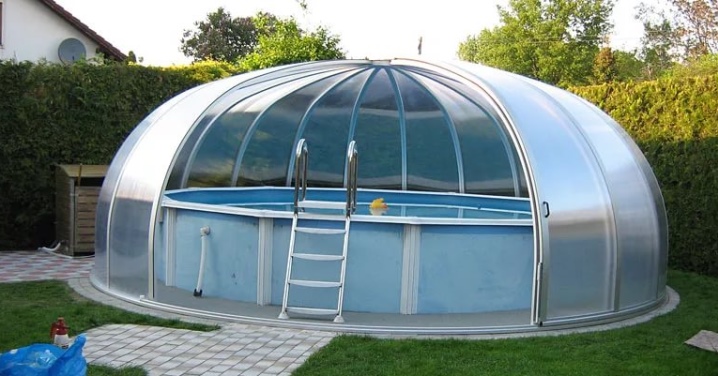
Many people perceive the pool in a private house as a daily source of pleasure, especially on a sultry day. And only the owners know how difficult it is to maintain it. It is necessary to install filters, daily purify the water from debris, leaves, insects, make sure that the tank does not bloom with algae, so that the frogs do not breed their offspring in it. The roof over the pool greatly simplifies the operation and maintenance process.
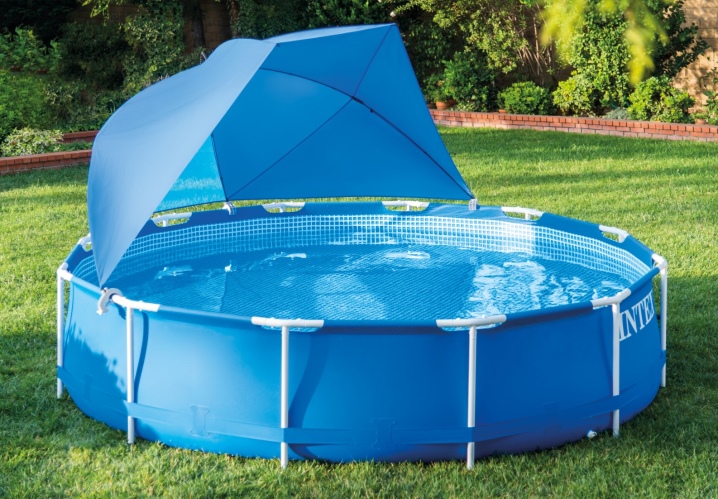
Types, their pros and cons
First of all, let's figure out what a frame pool is. This is a film factory building of various sizes, shapes and depths. It is installed on a leveled surface with a laid backing or mounted in a pre-prepared recess, then the edges of the pool become flush with the ground. The roof depends largely on the shape of the pool and where it is located (on or below the surface of the ground).
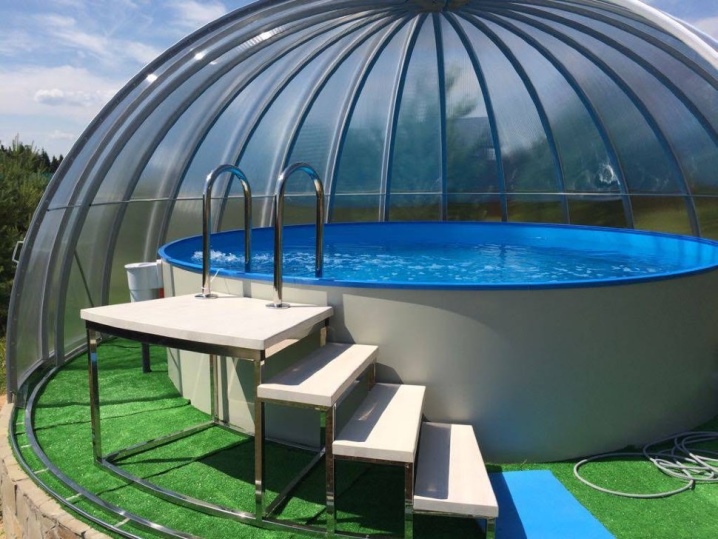
The cover over the pool greatly simplifies its operation; this design has quite a few advantages.
- First of all, the roof protects against pollution emanating from the external environment: fallen leaves, dirt, dust, precipitation.
- The coating, even transparent, refracts the sun's rays, protects the pool from direct exposure to ultraviolet radiation, and affects its durability. In addition, the reproduction of pathogenic bacteria and phytoplankton slows down, the water does not bloom.
- Moisture in an enclosed space evaporates less.
- The pool with a pavilion keeps you warm.
- The roof protects children and animals from falling into the water.
- Fewer chemicals are needed to purify the liquid.
- The indoor pool makes it possible to use it at any time of the year.
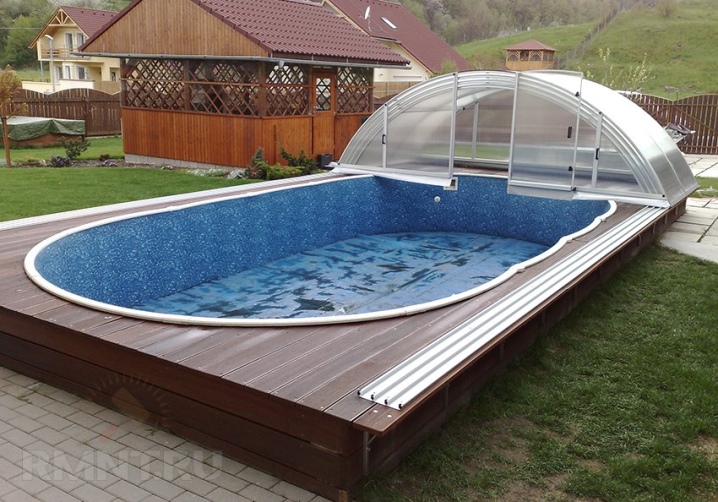
Unfortunately, there are also several downsides.
- Price. The more thorough and reliable the protection is, the more you will have to pay for it.
- Care. For example, a polycarbonate roof can squeeze and crack under the pressure of a snow cap, requiring periodic cleaning. If the pool is in the country, you will have to visit it in winter.
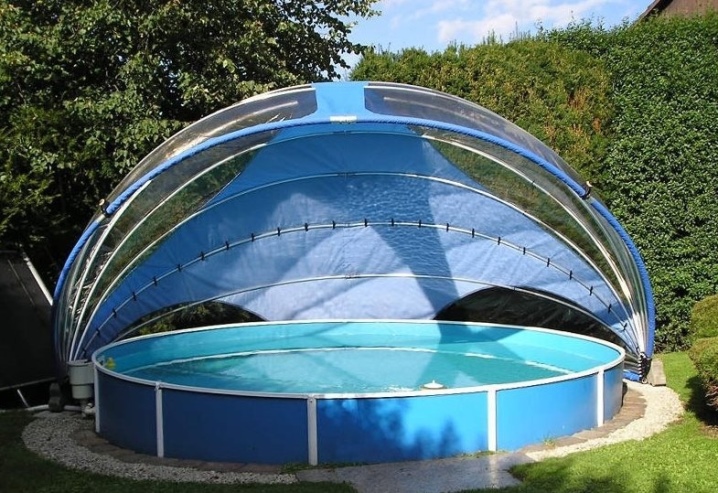
Pool roofs have a wide variety of designs, and they differ in material. But all of them can be divided into three large groups: mobile, sliding and stationary.
Mobile (portable)
Mobile buildings are temporary. The pool is considered seasonal and fully open. Only if necessary, it is sheltered at night, in bad weather or at the end of the bathing season. Mobile structures are of two types: flat and domed. The flat coating is simple, the owners make it from any suitable size material purchased from a hardware store - for example, chipboard, aluminum sheet. They simply protect the pool from the external environment, and then just as easily remove the sheets or film.

Can be purchased from the factory with a collapsible dome. It can be easily installed over the pool and removed at any time if it is no longer needed. This is an inexpensive canopy, it is installed on an aluminum frame, it is covered with an awning on top. The range includes canopies for round, oval, square and rectangular pools in different sizes.

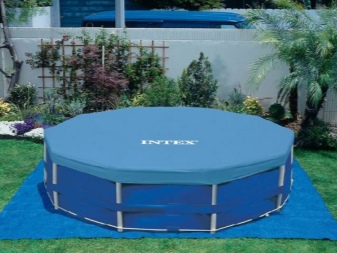
Mobile awnings have many advantages over stationary ones:
- they are economical, the costs for them are much lower than for the construction of a solid structure;
- are lightweight, easy to carry and transport;
- easily assembled and disassembled;
- on sale you can find a wide variety of models, choose the necessary size, shape, texture of the coating and color.
As for the shortcomings, you should not count on such designs throughout the year. They are used only during the swimming season.
They will not protect the pool from snow and frost, moreover, their durability is much inferior to that of stationary models.
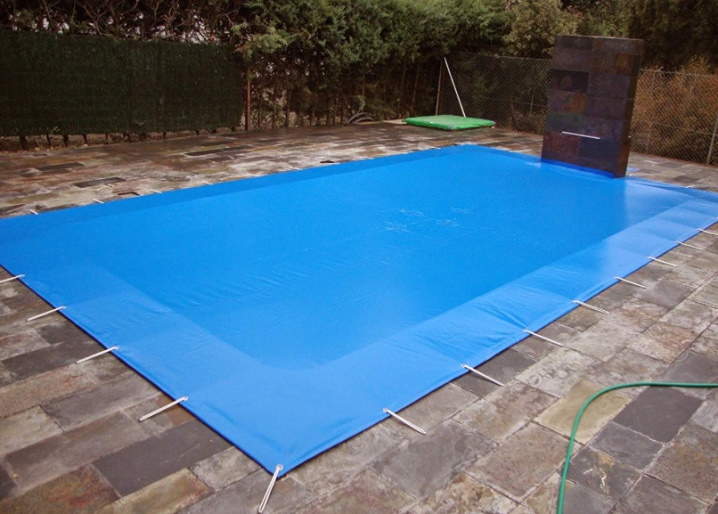
Stationary
Solid structures that are erected over the pool. They are of several types. The first is a frame made of a thick aluminum profile with a transparent polycarbonate coating. In appearance, they resemble greenhouses. The second ones are made in the form of buildings made of brick, glass and other components, they look more aesthetically pleasing, they can be stylized as landscape design and become its decoration. For frame products, the first option is most often used, since it is built faster and is cheaper.
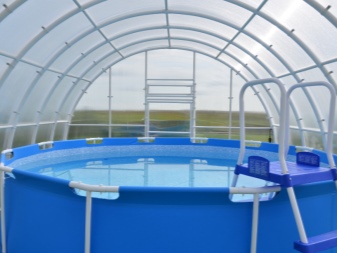
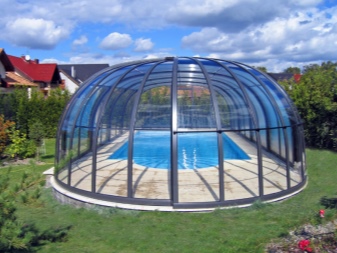
A stationary structure of any kind must have an entrance door and a ventilation system. Structures on an aluminum frame have enough windows for ventilation, while brick buildings should have a more reliable ventilation system, such as in a residential building. Often, stationary buildings are adjacent to the house and have a common entrance, this allows you to use the pool in the cold season.

A big plus of stationary buildings is the ability to use the pool throughout the year, regardless of the seasons and weather.
The downside is the high cost of the coating, and brick structures are also difficult to build. In addition, you will need ventilation, heating systems and plumbing.
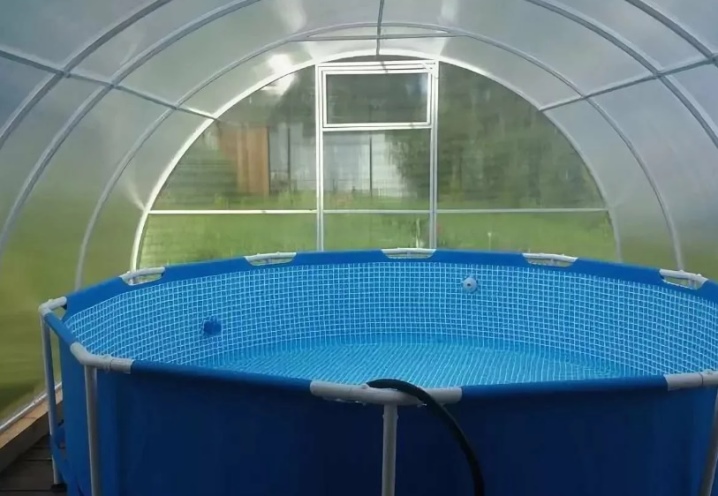
Sliding
Sliding pavilions are universal types, and today they are the most popular, as they provide an opportunity to swim, soak up the sun. And then you can close the pool, protecting it from the troubles of the external environment. Structures can be opened and closed in different ways.
- The most popular is the telescopic system, in which sections, while moving along the rails, hide one into the other, like nesting dolls. This system is a transparent polycarbonate tent covering and looks like a greenhouse.
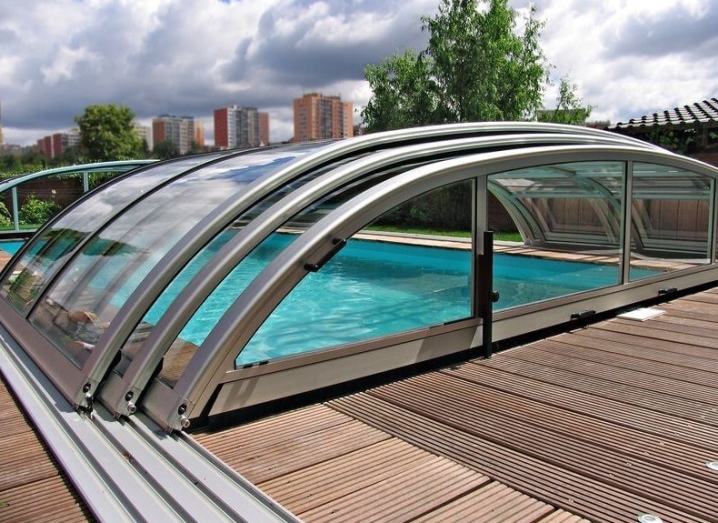
- The second type looks like a dome or hemisphere, divided into two equal parts. Moving along the rails, one half of the structure enters the other. The pool opens up to half, but this is enough to sunbathe and take an air bath.
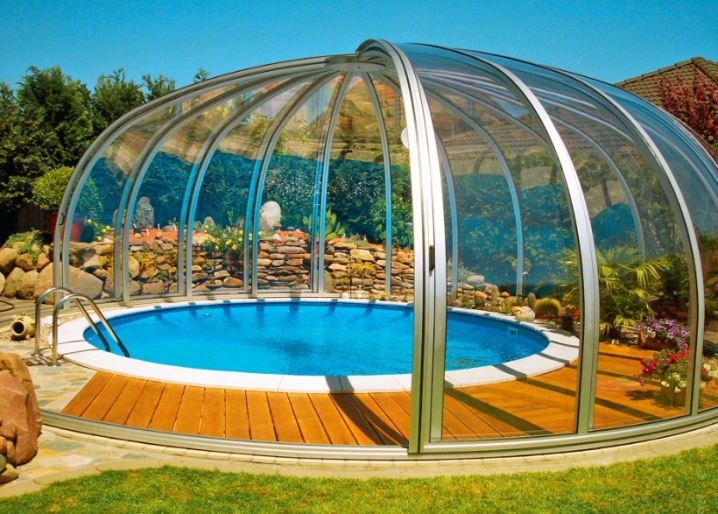
- The third type is suitable for a “recessed” pool that is level with the ground. It closes with a soft cover collected in a roll on a special holder.

The advantage of sliding pools is that they can be used as you like, as an open or closed space. But they, unlike stationary buildings, retain heat and moisture evaporation worse.

Installation rules
The simplest do-it-yourself pool cover consists of a wooden frame covered with polyethylene. For a more complex product, you will need a drawing. It is easy to find it on the Internet or make it yourself, taking into account the size of your own pool.
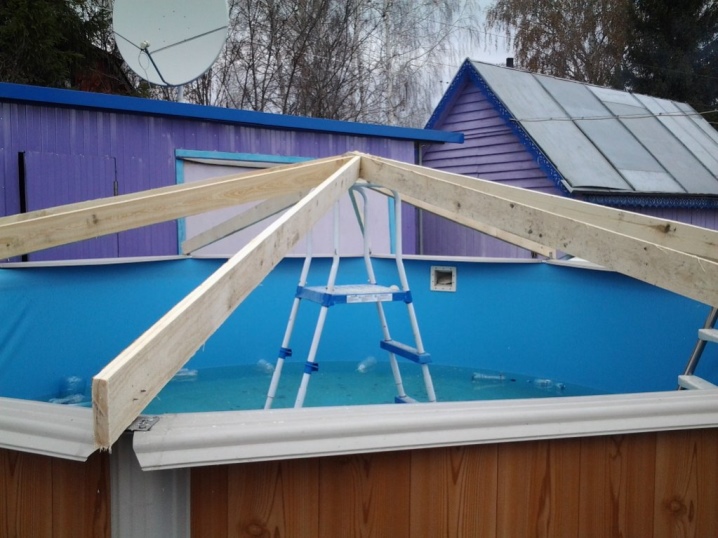
The frame can be made from a metal profile or pipe. When calculating the load, one should not forget about the winter adhesion of snow. The procedure is as follows.
- Around the pool, four holes are planned and dug under the racks. For a large reservoir, intermediate recesses will be needed. The bases of the posts must be coated with bituminous mastic to provide waterproofing. Then the racks will need to be installed in the prepared pits and cemented.
- The pillars are connected with a shaped pipe.
- Bends of pipes for arches are performed using a pipe bending machine.
- The width of the polycarbonate sheet is 2.1 m. To lay it, you need three arched spans.Knowing the size of your pool, it's easy to calculate how many cover sheets and arches you need.
- The polycarbonate coating is fixed to each other with transverse pipes.
- On the rafters prepared for polycarbonate, the connecting profile is fixed with self-tapping screws.
- Starting from the edge of the structure, the first polycarbonate sheet is inserted into the connecting profile and fixed using self-tapping screws for metal.
- The second sheet is brought into the next groove. In this way, all the prepared polycarbonate is mounted.
- At the final stage, the side edges of the coating are covered with a special profile.
This completes the entire installation process.
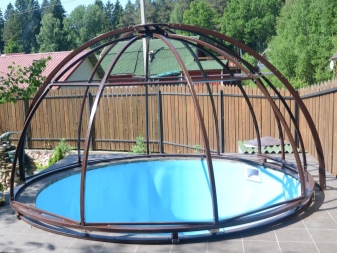
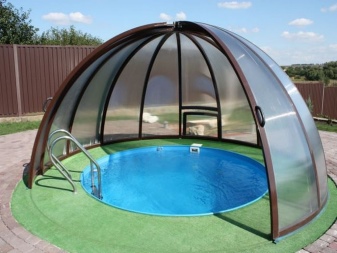
Exploitation
Any structure requires maintenance, and the pool cover is no exception. You need to use the structure as follows.
- For the building to be well preserved, it must be provided with ventilation. If a special ventilation system is not provided, the structure will often have to be ventilated.
- In windy weather, the sections should be fixed in time, windows and doors should be closed so that gusts of wind do not have the opportunity to damage the structure.
- Use a hose to periodically wash the polycarbonate sheets.
- The arched coating does not allow sediments to linger on the surface. But with heavy snowfalls, a hat is still formed on the sloping roof, and if it is not removed in time, polycarbonate can crack. The manufacturer claims the product's ability to withstand a load of up to 150 kg per square meter, but the destruction of roofs still sometimes occurs.
- The roof should be inspected periodically for cracks. It is better to replace the damaged sheet immediately.

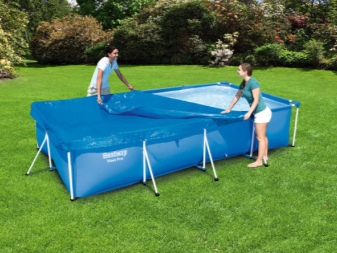
How to make an inexpensive wooden pool canopy on wheels, see the video.



































































The comment was sent successfully.